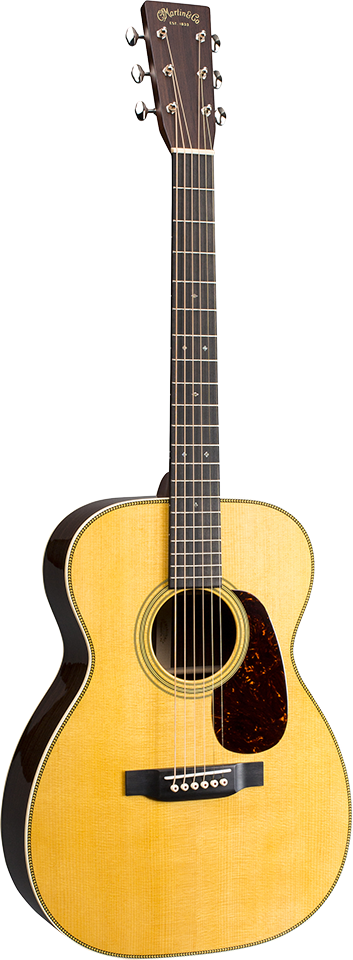Intro
When shopping for an acoustic guitar, taking the time to understand the basics of body styles and what you’re looking for can make all the difference. The body shape of your guitar will determine playing comfort, certain sound characteristics and the volume level you’ll hear. In this post, we’ll dive in and explore the ins and outs of different acoustic guitar body styles. Special thanks to C.F. Martin & Co. for allowing use of their images!
The main types of acoustic guitars are:
Dreadnought
Parlor
Jumbo
Grand Performance/Grand Auditorium
Orchestra (OM)
Concert & Grand Concert
Classical
Travel Guitars/Small Body Guitars
Dreadnought
The dreadnought, named for an early 20th century British battleship, was originally designed by the CF Martin company, and remains one of the most popular acoustic guitar body types today. Many other companies have since adopted the overall dreadnought style and produced slightly variant models.
The dreadnought is characterized by its large body which produces increased volume and a strong attack. This guitar has strong presence, significant bass and great highs, making it a favorable body style for ensemble bluegrass players, folk artists or singer-songwriters.
Parlor
Also originally designed by the CF Martin Company, the parlor guitar is one of the oldest body styles on the market. Mass produced in the 19th century, the shorter scale and smaller body allowed manufacturers to keep costs low, which made parlor guitars more affordable to the general public. They were incredibly popular up until the early 1960s, and were played among many blues players, including Robert Johnson and Lightnin’ Hopkins. While the model dipped in popularity for a time, it is making a comeback with contemporary musicians.
Parlor guitars are smaller than concert guitars and they tend to have an elongated body. Parlor guitars produce an impressive tonal balance despite their size. While not as loud as a dreadnought, parlor guitars still project a decent amount of volume. They are popular among singer-songwriters as they provide a well-balanced sound and are easy to travel with.
Jumbo
Gibson created the jumbo guitar body style in 1937. As the name implies, jumbo guitars are very large and have a noticeably rounder body style, allowing for a significant amount of volume and projection. The sound of a jumbo guitar produces more bass frequencies which can be beneficial for fingerstyle playing. While the guitar has an edge among others when it comes to volume and bass output, the larger body style may be cumbersome for some, especially smaller players.
Orchestra Model (OM), Grand Performance (GP) & Grand Auditorium (GA)
The OM, GP & GA guitars are very comparable in size and are slightly smaller than the dreadnought. The biggest difference from the OM compared to the GP or GA is that the OM has a slightly thinner body style. These different models all function well for a mid-size guitar and they produce a broad and balanced sound. The GP is a model made by Martin whereas the GA is a similar body style that it made by the Taylor guitar company. The waist of the OM and GP/GA guitars can be more comfortable for some people to play since they curve to fit the leg better.
Concert & Grand Concert
The concert guitar has a body style based on the classical guitar model, with a body size just slightly larger than the parlor guitar. This guitar body works well for smaller guitar players, and the sound works great for fingerstyle players. There isn’t as much bass as in the larger guitar models, but the mid-range frequencies resonate very well. The grand concert guitar is larger than the concert, and provides more volume and bass.
Classical
Classical guitars are made with nylon strings and are meant to be used in classical, flamenco, spanish or fingerstyle genres. It’s more common for classical guitars to have wider necks yet slightly shorter in scale than steel string acoustics. It’s also typical for classical guitars to not have fret inlays displayed on the fingerboard. The body style is comparable to a concert size guitar. Due to the nylon strings and body style, the classical guitar has a warm sound with noticeable bass and good mid-range tones.
Travel
Travel guitars are significantly smaller than full-sized guitars (parlor styles included). The dimensions on most travel guitars are proportionately sized down (ex: Little Martin or Baby Taylor models). Some travel guitars maintain a full size neck while the body is significantly smaller or shaped differently (ex: Traveler guitar or Martin’s Backpacker model).
While there are a variety of different styles and sizes of travel guitars, they are all designed for one thing: traveling. They’ll almost always have reduced volume and tonal range quality. However, they are a great space saver if you are on the move.
Conclusion
While it’s true that almost all acoustic guitars have a curved and round body shape, remember they come in a wide variety of sizes and sounds. Specific models may be a better choice for certain players, depending on body size or personal preference. Before buying, remember to do your research, test the sound, and know what you’re looking for!






